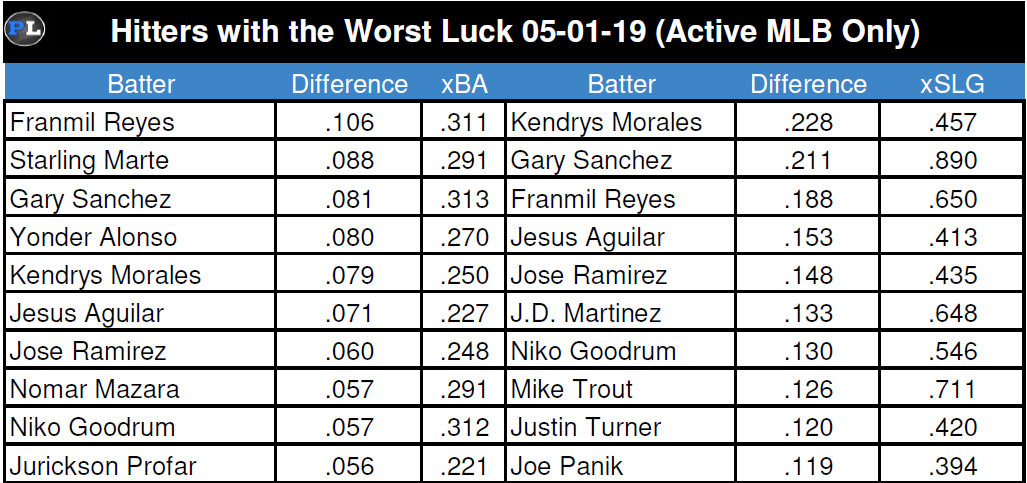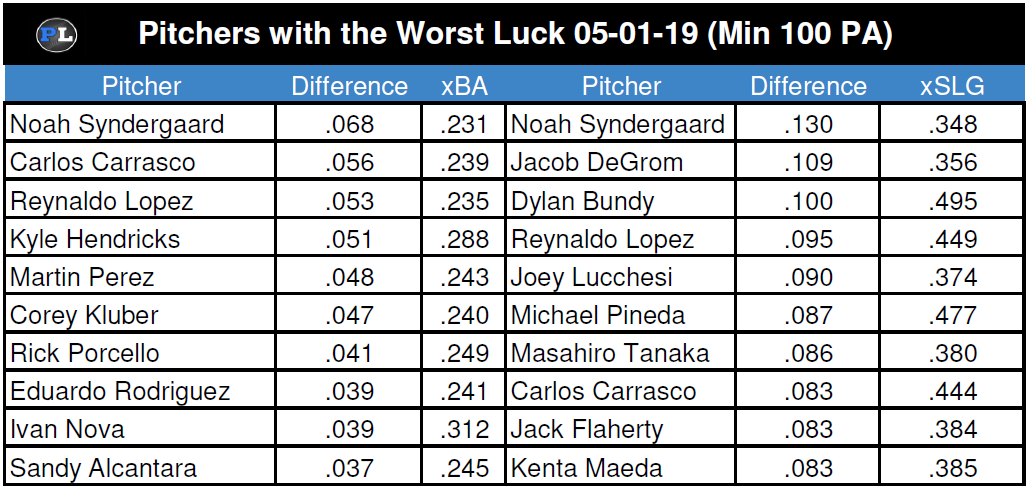It’s been quite a month for baseball — home runs are up, Aces aren’t Ace-ing, and folks are just dying know whether the trends and stats they’re seeing in their fantasy lineups are meaningful. A month of baseball generally isn’t long enough to give us definitive answers, but it IS long enough to try and make some hot takes using Statcast, so let’s have some fun with it. We can start with an update on the widest disparities between actual and expected outcomes:

One of these names should not be surprising to you — we’ve been talking for a while now about the miserable luck of Franmil Reyes (OF, San Diego Padres), who at the very least is reversing his fortunes in the slugging department after two multi-HR games on April 23rd and 30th. He leads the league in barrels per plate appearance with 14.3, so it’s no surprise that we’re seeing these power outbursts. His batting average will hopefully start to turn around as well, and the nice thing is that we don’t even have to ask him to make any changes: His 22% strikeout rate is much more reasonable than the 28.1% he showed last season.
Kendrys Morales (1B/DH, Oakland Athletics) has also had issues with lady luck so far, a problem that was present throughout 2018 as well. Last season, Morales’s .272 xBA was 23 points higher than his actual BA, which was the 11th largest gap among players with 450+ PA. Even worse, his .526 xSLG was a whopping 88 points higher than his actual slugging, making him the unluckiest guy in the league when it came to SLG-xSLG. Part of the issue for Morales is that he can’t really stretch out doubles or singles like most players, considering his 23.4 sprint speed, which is tied with Miguel Cabrera and is the ninth slowest pace in the league. All that being said, better days are hopefully ahead for the switch-hitter, as he continues to make solid contact.
It’s fairly comforting to see Jose Ramirez (2B/3B, Cleveland Indians) on this list after he was a popular pick at third overall in drafts. We’re still waiting on the power, as he has just two home runs on the season, but he has a .413 OBP over the last 10 days in combination with four steals, so at least he’s contributing something for fantasy owners. His .248 xBA and .435 xSLG aren’t impressive, but they are at least less depressing than his actual .181 BA and .276 SLG.
Bring on the Barrels
Barrels, which are batted balls expected to have a batting average of least .500 and a slugging of at least 1.500 based on their exit velocity and launch angle, are the best raw measure of quality contact we have available. Because these batted balls require a high level of skill and power, it’s safe to assume that hitters will be unable to accidentally generate elevated barrel rates for any sustained period of time. With a month of the season in the books, it’s an excellent time to take a peek at a few hitters are showing fantasy-friendly barrel rates.
Luke Voit (1B, New York Yankees) had a bit of a slow start to the year, but since April 22nd he has 4 HRs, 10 R, and 10 RBI with a .394/.500/.788 batting line. He’s tied for the league lead in barrels this season as well, with 16 in 75 batted balls (12.7 Barrels/PA). Among batters with at least 25 batted balls in 2018, no one had more barrels per plate appearance than Voit, which suggests the late breakout is more likely real than not. Our own Nick Gerli covered Voit early on in the preseason and found some interesting comparisons and trends that are worth reading about. Even as the Yankees recover from their rash of injuries, it’s safe to assume that Voit will have a permanent place in the batting order and will provide power all season long.
Christian Walker (1B, Arizona Diamondbacks), like Voit, is a late-bloomer who many have been slow to believe in after coming out of nowhere and starting the season with an impressive display of power. Through April, he is third in Hard Hit Rate (the percent of batted balls with an exit velocity of at least 95 mph) at 58.2%, which goes quite well with his 14.5 degree average launch angle. His average exit velocity on fly balls and line drives is an impressive 99.2 mph, which just ahead of some guy named Christian Yelich and right behind some other guy named Pete Alonso, which I’ve heard from my colleagues is pretty good company at this point in the season. For some reason, he’s still available in 30% of Yahoo leagues and 47% of ESPN leagues, so you happen to be in one of those leagues, take a moment to open up your waiver wire and claim him.
I’ve always had a fascination with Avisail Garcia (OF, Tampa Bay Rays), largely due to the power that has been hidden in his bat by his high ground ball rates. He’s 11th among players with at least 60 batted balls in barrels per plate appearance, and I’m starting to think that the Rays are the new Astros in how they’ve acquired interesting players and given them an opportunity to be, well, interesting. He has always been a standout in barrels, but the more interesting thing for him has been his slow but steady growth in lifting the ball. His current launch angle is 10.2 degrees, which is slightly below the league average of 12.7, but it has gone up every year since 2016 (which is when we started tracking this publicly) from 5.34, then to 7.5, and then to 9.7 last season, when he hit a career high 19 home runs in just 93 games. He’s kind of like a bigger, taller version of Yandy Diaz, who the Rays also famously acquired. He’s a good name to add to your watch list.
Starting Pitchers with Bad Luck
To wrap things up in this Statcast update, we’ll take a look at some pitchers who are facing big differences in their xSLG and SLG and who might be good buy-low or rebound candidates:

While some of these names are easy to ignore, a few are noteworthy. First, if you’ve been worrying about Noah Syndergaard (SP, New York Mets), you can rest a little easier knowing that the issue probably isn’t his elbow or his shoulder. More likely, his issue is some umbrella he opened inside a building or a mirror he broke. Not only does he have the widest gap in ERA-FIP at 2.65, but he’s also on top of both the xBA-BA and xSLG-SLG charts. That’s basically the bad luck trifecta. His .292 BA-allowed is the sixth highest in baseball, but if it mirrored his xBA-allowed, it would look a lot like what James Paxton has allowed. His .478 SLG-allowed is the 26th highest, but his 3.48 xSLG-allowed mark, if real, would be similar to what Shane Bieber and Gerrit Cole have done so far. In other words, Thor is still Thor — he just can’t catch a break.
The maddening Reynaldo Lopez (SP, Chicago White Sox), who recently tossed an impressive gem against the Tigers, striking out 14 in six innings while allowing just one unearned run, also finds himself towards the top of both lists. He doesn’t have the track record of mighty Thor, but we’ve been tantalized by his potential for the better part of a year now. He’s prone to awful outings due to inconsistency with his secondary pitches, but he’s a great streaming candidate in 10 and 12-team leagues, and 15-team players can rely on him against lesser foes or in spacious parks.
Joey Lucchesi (SP, San Diego Padres) has been more Fugghesi of late, allowing five or more runs and seven or more hits in three of his last four outings after starting out with back-to-back appearances with no runs allowed. He’s not walking a lot of batters and he’s piling on the strikeouts, so his presence on the xSLG-SLG list helps explain the rough start. He’s struggling with first pitch strikes, which is troublesome, but he has been overly punished for his mistakes thus far. His .374 xSLG-allowed is better than Blake Snell’s .378 actual SLG-allowed, and though I don’t expect a full reversal of fortune, it’s enough of a ray of hope for me to hold on to Lucchesi in 12-team leagues.
(Photo by Bennett Cohen/Icon Sportswire)

Confused….xBA minus BA and xSLG minus SLG being high positive numbers should mean you are getting lucky, right? Your words on Syndergaard suggest the opposite. Has he been lucky or unlucky?
Should have specified I’m talking about for Pitchers
Good catch — I messed that up a little for both. Both the hitter and pitcher tables indicate who has been UNLUCKY. I’ll tweak those images shortly, but the numbers in the table show the difference between the two figures, as opposed to the raw calculation.
EDIT: As of 3:03pm on 5/2, the tables have been corrected to eliminate the confusion.
thanks Scott!
The inclusion of Kendrys Morales raised my antennae because he’s consistently underperformed his Statcast data for the past several years. As of this post, Morales has a .154 BA and .238 xBA, which makes it seem like he should be due for positive regression.
But we know Statcast estimates are systematically biased because they don’t take into account player speed or batted ball direction. Statcast is more likely to overrate players who: (1) are slow, (2) make hard contact on pulled grounders, or (3) make hard contact on balls in the air to center.
I looked at Morales’ Statcast data by batted ball type and direction to get a sense of how much these last two biases might be at play here. If we look at up-the-middle/opposite-field grounders along with line drives/fly balls to the pull/opposite fields, we see he’s been a bit unlucky. He is hitting .275 on these batted balls, while Statcast estimates an xBA of .344.
But on pulled grounders and air balls to center, the difference is quite stark. Morales’ xBA is .266, even though he is 1-for-18 on these balls, an .056 average. These two batted ball types account for 48 of the 84-point gap between his BA and xBA. If you apply Statcast estimates only to the other group of batted balls, Morales’ xBA lowers to .190—performance that doesn’t exactly make you sprint toward the waiver wire.
That’s some nice research, James! It’s been proven that sprint speed and xBA have a direct correlation based on how much slower than average a player is (and as I mentioned, Kendrys is MUCH slower than average). That said, it wouldn’t account for the entire gap — per Alex Chamberlains RotoGraphs article on the topic last November, Kendrys’ lack of speed only explains a about 30 points of it. Still, it’s a good point that plodders will always appear on this list. I doubt anyone in 10- or 12-teamers want him (and they shouldn’t), but he’s watch-list worthy for power-starved managers in deep formats, especially with the vastly improved plate discipline he’s showing so far.